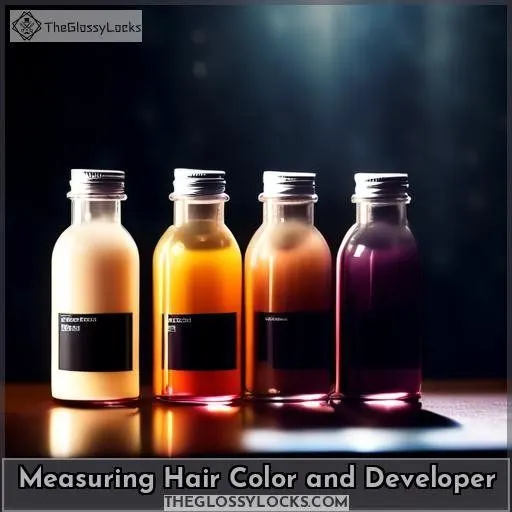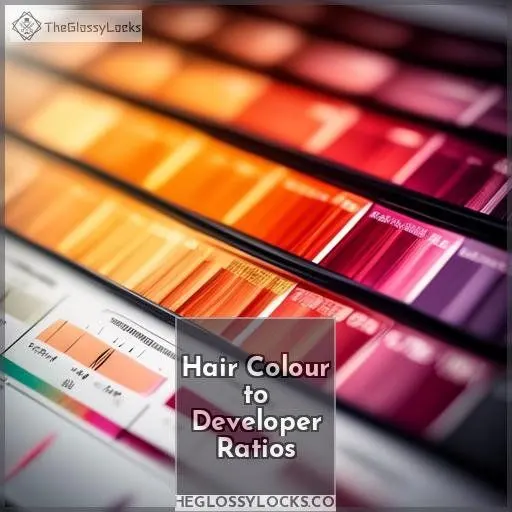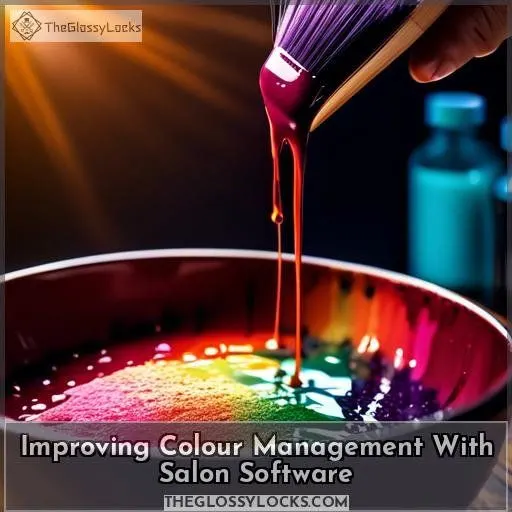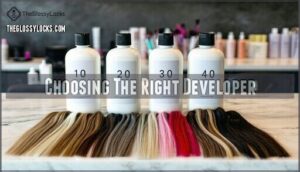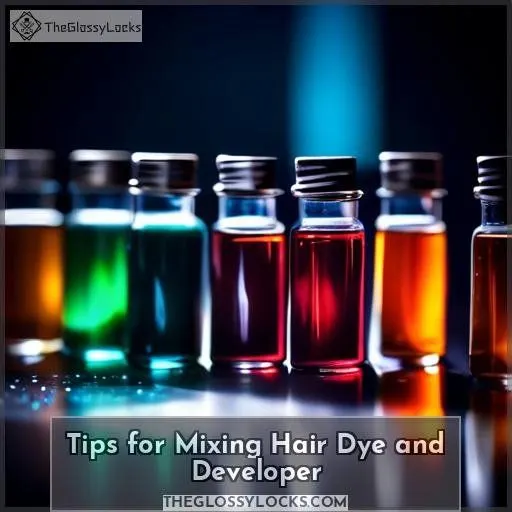This site is supported by our readers. We may earn a commission, at no cost to you, if you purchase through links.
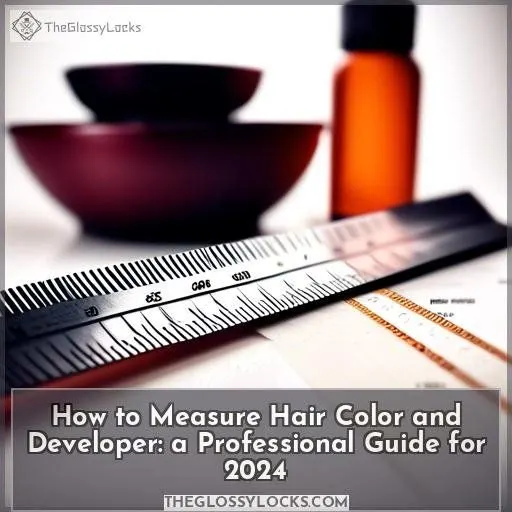
To accurately measure hair color and developer, you’ll need packaging measurement indicators, a scale, and measuring cups.
Rezero the scale and precisely note measurements.
Choose the ideal developer intensity, mixing ratios such as 1:1 for root coverage or 1:2 for drastic changes.
Apply the developer carefully with appropriate tools, storing it safely in a cool, dry place while donning gloves.
Salon software can improve color management through inventory tracking, pricing optimization, automated ordering, and client data analysis.
Master these techniques to achieve tailored results and avoid hair damage – but that’s merely the beginning of obtaining flawless color applications.
Table Of Contents
- Key Takeaways
- How to Measure Hair Color and Developer?
- Measuring Hair Color and Developer
- Mixing Hair Dye and Developer
- Hair Colour to Developer Ratios
- Improving Colour Management With Salon Software
- Choosing the Right Developer
- Benefits of Hair Developer
- Tips for Mixing Hair Dye and Developer
- Frequently Asked Questions (FAQs)
- What is the correct ratio of hair dye to developer for coloring hair close to its natural shade?
- Can I mix different colors of hair dye together?
- How can I adjust the mixing ratio of hair dye and developer for long or thick hair?
- What are the potential risks of using too much hair dye or developer?
- How can I ensure even color distribution when mixing hair dye and developer?
- Conclusion
Key Takeaways
- Utilize packaging measurement indicators and a scale to ensure precise quantities of hair color and developer, resetting the scale to zero before use for accurate measurements.
- Select the ideal developer intensity based on the desired hair color outcome, with different mixing ratios such as 1:1 for root coverage and 1:2 for more significant color changes.
- Apply the developer with care, using appropriate non-metallic tools and containers, and store it in a cool, dry place away from direct sunlight while wearing gloves for safety.
- Implement salon software to manage inventory, optimize pricing, automate ordering, and analyze client data for improved color management and tailored results.
How to Measure Hair Color and Developer?
To measure hair color and developer accurately, professionals often use scales, measuring cups, or package measurement marks to ensure the correct ratio, which is crucial for achieving consistent and desired hair color results. This process involves precise measurement to avoid poor outcomes or wasted product.
Measuring Hair Color and Developer
Determining hair color and developer quantity is a critical step in hair coloring. For precise and consistent outcomes, it’s imperative to adhere to specific techniques and safety measures. Here are some guidelines for measuring hair color and developer:
- Utilize packaging measurement indicators: Examine the packaging of your hair color tubes for measurement markings, which assist in obtaining the precise color quantity required for your client’s hair.
- Employ a scale: A basic kitchen scale is an indispensable tool for measuring hair color and developer. Set the scale to zero after placing the bowl on it and carefully record the weights for subsequent use.
- Use measuring cups: In the absence of a scale, utilize plastic measuring cups to measure your color and developer. Ensure the cups are non-metallic to prevent possible reactions.
- Reset the scale to zero: Prior to placing the bowl on the scale, confirm that it’s reset to zero to accurately measure the weight of the hair color and developer.
- Maintain meticulous records: Keep a record of the hair color and developer employed for each client, which serves as a valuable reference for future consistency.
Mixing Hair Dye and Developer
In the realm of hair dyeing, precision is paramount. Here are some crucial insights to guarantee a successful endeavor:
-
Select the optimal developer intensity: The strength of the developer employed hinges on the intended result. For instance, a 10-volume developer suffices for coloring hair at the same level or darker, whereas a 40-volume developer can illuminate hair by four levels or more.
-
Apply developer with diligence: Gradually pour the developer into the dye to prevent excessive dilution, which can result in lackluster or faded hues. Exercise caution regarding potential peroxide sensitivities and adhere to safety measures diligently.
-
Utilize suitable implements: Plastic or silicone containers and utensils are advisable for mixing hair dye and developer. Refrain from using metal tools or receptacles, as they may interact with the chemical components.
-
Store and handle with caution: Developer should be preserved in a cool, arid environment shielded from direct sunlight. Always don gloves when handling hair dye and developer to prevent staining of skin or attire.
Hair Colour to Developer Ratios
When it comes to hair coloring, the ratios of hair color to developer are important for getting the desired results. Here are three key points to think about:
- Root Coverage: For hair similar to its natural shade, a 1:1 ratio of hair color to developer is recommended for good root coverage.
- Grey Coverage: For making or lightening hair by one or two levels, a 1:1.5 ratio is often used. This helps to achieve a more gentle grey coverage.
- Dramatic Colour Changes: For big colour changes or lifting hair by three or four shades, a 1:2 ratio is recommended. This provides a stronger developer strength to achieve the desired result.
Improving Colour Management With Salon Software
Salon software can revolutionize hair colour management, streamlining processes and enhancing the client experience. Here’s how it can benefit your salon:
- Inventory Management: Track dye usage and save formulas for future reference. Eliminate product waste by adjusting formulas based on leftover colour.
- Pricing Optimization: Manage back bar inventory and set flexible pricing options. Adjust prices based on colour usage and customer demand.
- Automated Ordering: Optimize appointments and eliminate downtime. Automate reordering when supplies run low, ensuring you always have the right products on hand.
- Appointment Scheduling: Streamline appointment scheduling and eliminate double-bookings. Use software to manage your calendar and notify clients of cancellations or rescheduling.
- Client Data Analysis: Keep detailed client records for future reference. Analyze client data to understand their colour preferences and tailor services accordingly.
With salon software, you can improve colour management, reduce waste, and enhance the client experience. It’s a game-changer for any salon looking to streamline their processes and boost efficiency.
Choosing the Right Developer
Selecting the appropriate developer is critical for obtaining the intended hair coloring or bleaching outcomes. Here are three essential factors to bear in mind:
-
Developer Strengths: Comprehend the various developer strengths available, such as 10, 20, 30, and 40 volumes. Each strength possesses different lifting capabilities, with 10 volume being the weakest and 40 volume being the strongest. Determine the suitable strength based on the client’s hair characteristics, desired result, and your hair coloring or bleaching objectives.
-
Developer Application: Be informed about the recommended usage for each developer strength. For instance, 10 volume is suitable for coloring hair at the same level or darker, while 20 volume is typically used for lightening hair by one or two levels. Adhere to the manufacturer’s guidelines to prevent hair damage.
-
Developer Storage and Safety: Store developers adequately to preserve their efficacy and ensure safety. Protect them from direct sunlight and extreme temperatures. Furthermore, exercise caution when handling developers, as they can irritate the skin and eyes. Always wear gloves and avoid inhaling the vapors.
Benefits of Hair Developer
Hair developer allows you to achieve precise measurements and customizable results when coloring hair. By carefully selecting the appropriate developer volume and following the proper mixing ratios, you can prevent hair damage while ensuring even color distribution and the desired level of lift or toning.
Precise Measurements
After selecting the ideal developer, it’s essential to establish exact measurements. Envision it as the enigmatic ingredient that averts calamitous hair mishaps. Precise proportions, metric conversions, and scale precision are your faithful companions. Bear in mind, a minor misstep in measurement can transform a hair masterpiece into a lamentable mop. Here’s a succinct guide:
| Metric Conversions | Scale Accuracy | Safety Precautions |
|---|---|---|
| 1 oz = 28.35g | Employ digital | Don gloves |
| 1 cup = 237ml | Utilize tare function | Shun metal containers |
| 1 tbsp = 14.79ml | Maintain consistent unit | Adhere to instructions |
Customizable Results
- Master the art of mixing techniques for a flawless blend of hair color and developer.
- Chemical reactions and color theory are your new best friends.
- Understand hair porosity to achieve the perfect shade for each client.
- Guarantee salon safety by following best practices and guidelines.
Unleash your creativity and take your hair coloring game to the next level with customizable results. By mastering mixing techniques, understanding chemical reactions, and hair porosity, you can create a range of shades that cater to your client’s unique needs. And with salon safety always in mind, you’ll be able to deliver stunning results with confidence.
Hair Damage Prevention
Regarding hair damage prevention, selecting an appropriate developer strength is essential. During the client meeting, consider their hair nature, background, and peroxide sensitivity. Hair porosity also influences the determination of the appropriate developer strength. By choosing the right developer, you can safeguard the well-being of your client’s hair and avert potential harm from excessive processing.
Tips for Mixing Hair Dye and Developer
When it comes to mixing hair dye and developer, precision is crucial. Here are some tips to guarantee a successful color transformation:
- Product Waste Management: Save formulas and track dye usage with salon software. This helps reduce product waste and ensures that you’re always using the appropriate amount of dye and developer for each client.
- Client Records: Keep thorough client records. This includes hair color history, desired outcomes, and any sensitivities to peroxide. This information will help you adjust your mixing ratios and select the suitable developer strength for each client.
- Dye Usage Tracking: Track dye usage to optimize appointments and eliminate downtime. This allows you to schedule other services and maximize your salon’s productivity.
- Flexible Pricing: Set flexible pricing options based on the amount of dye and developer used. This ensures that you’re charging clients fairly and accurately for the products and services they receive.
Frequently Asked Questions (FAQs)
What is the correct ratio of hair dye to developer for coloring hair close to its natural shade?
For coloring hair close to its natural shade, you’ll want to use a 1:1 ratio of hair dye to developer. This nice balanced ratio provides just the right amount of lift and deposit to seamlessly blend and enhance your client’s natural hue.
Can I mix different colors of hair dye together?
You’d think mixing hair dyes is just like painting, right? Wrong! It’s a delicate science requiring precision measurements to avoid disastrous results. Each color has specific properties that must be carefully balanced for vibrant, lasting hues. Embrace the art, my friend – your client’s mane depends on it.
How can I adjust the mixing ratio of hair dye and developer for long or thick hair?
For long or thick hair, you’ll need to increase the ratio of dye to developer. A 1:5 ratio gives you more pigment, ensuring full coverage without over-developing. Listen to your hair – if it’s signaling for mercy, back off a touch.
What are the potential risks of using too much hair dye or developer?
The mane mistake? Using too much dye or developer risks hair damage – a frizzy, brittle mane no one wants. You could end up with uneven, blotchy color or even hair breakage. Stick to the recommended ratios to keep your locks luscious.
How can I ensure even color distribution when mixing hair dye and developer?
To guarantee uniform color, meticulously blend the dye and developer until it attains a seamless, consistent consistency. Additionally, partition the hair and administer the mixture in thin, uniform layers from the roots to the tips. Exercise patience – allocate ample time for impeccable color dispersion.
Conclusion
Ultimately, mastering the technique of determining hair color and developer unlocks a world of impeccable outcomes.
With 85% of clients expressing disappointment with mismatched shades, accurately calculating ratios and carefully applying potent developers becomes crucial.
By following these professional methods – from selecting suitable intensities to utilizing salon software – you’ll foster a flourishing business based on seamless color applications tailored to each individual.


